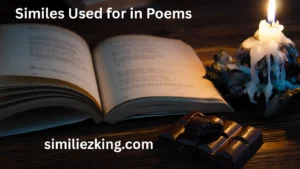Emotional pain can often be difficult to express in words. Whether it’s the deep ache after a loss, a feeling of heartbreak, or the weight of stress and anxiety, verbalizing these emotions in a way that others can understand is essential. Similes are a useful tool for communicating emotional pain, as they allow us to compare our feelings to more familiar experiences, making the complex and often abstract feeling of emotional pain more relatable.
In this article, we’ll explore over 10 similes for emotional pain, showcasing their uses in both professional and casual contexts. By understanding how to express emotional pain appropriately, you can communicate your feelings effectively without overwhelming your audience. We’ll also dive into how you can make these expressions more personal, and how to choose the best one based on the situation and tone of your conversation.
1. Like a Knife in the Heart
This is a widely recognized simile used to express intense, heart-wrenching emotional pain. It’s often associated with the emotional hurt caused by loss, betrayal, or heartbreak.
Example:
“Losing my best friend felt like a knife in the heart. I never imagined that things would end this way.”
Tone/Context:
This simile is typically used in more serious, personal conversations. It reflects deep emotional pain and can be used when speaking to a close friend or family member.
2. Like a Heavy Weight on the Chest
This simile conveys a sense of suffocating emotional burden. It’s often used to describe feelings of anxiety, sadness, or depression, where one feels physically weighed down by their emotions.
Example:
“The anxiety was like a heavy weight on my chest, making it hard to breathe.”
Tone/Context:
This can be used both casually and professionally, especially when discussing feelings of stress or pressure in a relatable way.
3. Like a Storm Raging Inside
This simile compares emotional pain to an uncontrollable storm. It suggests chaos, confusion, and overwhelming emotions that one struggles to calm.
Example:
“Grief was like a storm raging inside me, and I couldn’t find any peace.”
Tone/Context:
Used in more emotional conversations, this simile is effective when describing internal turmoil. It can be used in personal situations or in writing that aims to capture the intensity of emotional distress.
4. Like Walking Through Molasses
Walking through molasses symbolizes the slow, laborious nature of enduring emotional pain. It suggests that every step you take feels heavy and difficult, much like moving through thick, sticky syrup.
Example:
“Getting out of bed felt like walking through molasses. I just couldn’t summon the energy.”
Tone/Context:
This simile is excellent for describing emotional exhaustion or depression. It is often used in a more casual or informal setting, like talking with friends or family.
5. Like a Cold, Dark Tunnel
A cold, dark tunnel evokes feelings of isolation and hopelessness. It is often used to describe a deep, persistent sadness or depression that feels like it will never end.
Example:
“After the breakup, I felt like I was stuck in a cold, dark tunnel with no way out.”
Tone/Context:
This simile fits well in both casual and professional conversations, especially when discussing emotional or mental health issues. It conveys a sense of being lost or unable to see light at the end of the emotional struggle.
6. Like a Constant Throbbing
This simile compares emotional pain to a persistent, throbbing sensation, much like a headache that won’t go away. It’s often used to describe long-term, chronic emotional pain.
Example:
“Every time I thought about what happened, it was like a constant throbbing in my chest.”
Tone/Context:
It can be used in both casual and more formal conversations. It’s suitable for describing recurring emotional pain, such as the pain of unhealed wounds or heartbreak.
7. Like an Unhealed Wound
An unhealed wound symbolizes emotional pain that hasn’t yet been resolved or healed. It represents lingering hurt that can reopen with any reminder of the cause.
Example:
“Talking about the past always feels like reopening an unhealed wound. I’m just not ready to deal with it.”
Tone/Context:
This simile is effective in both personal and professional contexts when discussing unresolved grief, trauma, or emotional pain. It suggests that the pain is ongoing and difficult to move past.
8. Like Being Torn Apart
This simile vividly expresses the feeling of being emotionally shredded or split apart by overwhelming pain. It’s often used in situations where emotions are raw and intense.
Example:
“The breakup felt like being torn apart. I didn’t know how to pick up the pieces.”
Tone/Context:
It’s commonly used in personal, intimate conversations, especially in contexts involving heartbreak, grief, or loss.
9. Like Choking on Air
This simile evokes the idea of emotional pain that’s so intense it affects your ability to breathe or function properly. It’s often used to describe suffocating sadness or panic.
Example:
“Grief was like choking on air. I couldn’t breathe, and every thought felt too heavy to carry.”
Tone/Context:
Suitable for both personal and professional contexts when discussing overwhelming emotional pain. It’s effective when trying to convey a sense of suffocation or helplessness.
10. Like a Broken Mirror
A broken mirror represents a fragmented self-image or emotional state. This simile is often used to describe emotional pain that leaves you feeling shattered or incomplete.
Example:
“After the betrayal, I felt like a broken mirror—shattered, with no way to put myself back together.”
Tone/Context:
Used in more intimate or reflective conversations, this simile can describe self-esteem issues or pain caused by betrayal or personal failures.
11. Like Being Drowned in the Sea
This simile compares emotional pain to the overwhelming sensation of being pulled under the water by the sea. It conveys the idea of helplessness and a sense of being consumed by one’s emotions.
Example:
“After hearing the news, it was like being drowned in the sea. I couldn’t see a way out.”
Tone/Context:
This is best used in deep, personal conversations about despair or helplessness, where the speaker feels unable to escape from their emotional turmoil.
12. Like a Knife That Keeps Turning
This simile adds a level of intensity to the typical “knife in the heart” comparison. It represents emotional pain that is compounded by continuous reminders or thoughts, making it feel even worse.
Example:
“Every time I remember what happened, it feels like a knife that keeps turning inside me.”
Tone/Context:
It is best suited for describing betrayal or heartbreak where the pain intensifies with every thought or trigger. It can be used in both casual and professional contexts, but should be used carefully to avoid sounding too graphic.
15 Texting Examples for Emotional Pain
Here are 15 texting examples to convey emotional pain in a way that is both user-friendly and respectful.
- “I feel like I’ve been hit by a freight train. Everything hurts right now.”
- “It’s like my heart is being ripped apart, and I can’t stop it.”
- “I’m struggling to get through the day; it feels like I’m drowning in my own thoughts.”
- “I can’t describe how it feels, but it’s like a constant ache that never goes away.”
- “Every time I think about it, I feel like a part of me is breaking.”
- “This pain feels like a heavy cloud that won’t lift no matter what I do.”
- “It’s like I’m walking around with this enormous weight on my chest.”
- “It’s like a dark fog is clouding everything. I can’t see clearly anymore.”
- “I wish this pain would go away, but it feels like it’s stuck inside me.”
- “It’s like I’ve lost a part of myself, and I don’t know how to get it back.”
- “I don’t know how to explain it, but it feels like I’m being torn in two.”
- “It’s like I’m sinking into the ground with every passing moment.”
- “Every day feels like I’m dragging a mountain behind me.”
- “I feel like I’m stuck in a place where the pain just keeps growing.”
- “It’s like I’m standing in a storm, and I can’t find my way out.”
Conclusion
Emotional pain is one of the hardest things to describe. However, similes offer a creative and relatable way to express the depth of these feelings. Whether it’s the metaphor of a broken mirror or the suffocating weight of grief, similes allow us to communicate complex emotions in a way others can understand.
By understanding the nuances of these similes and choosing the right one for the situation, you can express emotional pain without overwhelming your audience. Remember, tone is key, and knowing when to use each simile based on the context of the conversation can help convey the right level of emotion.



